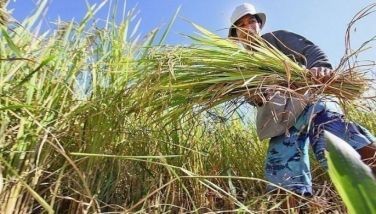Corn Board urges yellow corn farmers to raise their output
December 5, 2004 | 12:00am
The National Corn Competitiveness Board (Corn Board) is urging farmers to sustain their production of yellow corn in view of an expected tightness in global supply.
Corn Board vice-chairperson Joji Ilagan-Bian unveiled recently the recommended action points and strategies aimed at making the sector globally competitive and meet the rising local requirements of both poultry and livestock industries.
Ilagan-Bian also laid out the livestock demand scenario in the next six years, as well as the corn production forecasts from 2005 to 2010.
Larry Digal, one of the industry’s consultants, said: "For 2005 and beyond, there is a foreseen global tightness in corn supply due to China’s unusually high levels of procurement."
He added that China has been increasing its procurement of corn from the United States and Brazil and its purchases are now at 5 to 10 percent higher than last year.
The Philippines imports at least one million metric tons of yellow corn a year from neighbors in Asia and even from the United States to feed its robust livestock sector.
Corn Board vice-chairman and Jobs Undersecretary Theresa Cruz-Capellan said "with the increased demand from China and the country’s foreign exchange situation, the livestock and poultry raisers will have to rely on local corn supply for its feeds requirements."
Capellan added that "corn growers should now expand local production and co-invest with livestock and poultry raisers so as to benefit from the good corn prices that are predicted to carryover till next year."
She said "unless this is done, the windfall profits of the corn industry will not toll heavily on the livestock and poultry industries. Then, the boom-and-bust cycle of the corn and livestock sectors will see no end."
Capellan said "corn prices in December this year are expected to move upwards from $78.44 per metric ton, for a minimum of 200MT, to about $82.67/MT in March 2005, $85.43/MT in May 2005, $88.18/MT in July 2005, then $91.33/MT in September 2005 and finally, $94.88/MT at the end of next year."
She said these prices would mean dimmer prospects for corn imports, yet brighter future for corn production locally.
The trend in commodity futures, as benchmarked by the Chicago Mercantile Exchange, Minneapolis Grains Exchange, and Commodities Exchange of New York, was used as basis for the price forecasts.
Earlier, Corn Board chairperson Doris Magsaysay-Ho rallied the support of the private sector to help farmers raise their productivity by investing in corn production, processing and marketing.
Magsaysay-Ho said that in the domestic front alone, "the demand for feeds is already expanding as the livestock sector annually grows at 3.7 percent, or about 5.3 million metric tons a year. If the poultry sector is included, demand triples as growth of poultry is at 5.5 percent per year."
Corn Board members are optimistic that the developments locally and abroad will encourage Philippine corn farmers to expand production and increase their yields by adopting hybrid corn technologies, and even biotechnology.
Early this year, Capellan pushed for the expansion of areas planted to hybrid corn. In partnership with the Corn Board, Capellan has likewise mobilized industry stakeholders to invest in postharvest and marketing facilities to expand hybrid corn areas to 200,000 hectares in the next three years.
These additional agribusiness areas can take advantage of the call of President Arroyo’s job creation agenda as well as help stabilize meat prices by providing hog and poultry raisers with reasonable prices of feeds.
Corn Board vice-chairperson Joji Ilagan-Bian unveiled recently the recommended action points and strategies aimed at making the sector globally competitive and meet the rising local requirements of both poultry and livestock industries.
Ilagan-Bian also laid out the livestock demand scenario in the next six years, as well as the corn production forecasts from 2005 to 2010.
Larry Digal, one of the industry’s consultants, said: "For 2005 and beyond, there is a foreseen global tightness in corn supply due to China’s unusually high levels of procurement."
He added that China has been increasing its procurement of corn from the United States and Brazil and its purchases are now at 5 to 10 percent higher than last year.
The Philippines imports at least one million metric tons of yellow corn a year from neighbors in Asia and even from the United States to feed its robust livestock sector.
Corn Board vice-chairman and Jobs Undersecretary Theresa Cruz-Capellan said "with the increased demand from China and the country’s foreign exchange situation, the livestock and poultry raisers will have to rely on local corn supply for its feeds requirements."
Capellan added that "corn growers should now expand local production and co-invest with livestock and poultry raisers so as to benefit from the good corn prices that are predicted to carryover till next year."
She said "unless this is done, the windfall profits of the corn industry will not toll heavily on the livestock and poultry industries. Then, the boom-and-bust cycle of the corn and livestock sectors will see no end."
Capellan said "corn prices in December this year are expected to move upwards from $78.44 per metric ton, for a minimum of 200MT, to about $82.67/MT in March 2005, $85.43/MT in May 2005, $88.18/MT in July 2005, then $91.33/MT in September 2005 and finally, $94.88/MT at the end of next year."
She said these prices would mean dimmer prospects for corn imports, yet brighter future for corn production locally.
The trend in commodity futures, as benchmarked by the Chicago Mercantile Exchange, Minneapolis Grains Exchange, and Commodities Exchange of New York, was used as basis for the price forecasts.
Earlier, Corn Board chairperson Doris Magsaysay-Ho rallied the support of the private sector to help farmers raise their productivity by investing in corn production, processing and marketing.
Magsaysay-Ho said that in the domestic front alone, "the demand for feeds is already expanding as the livestock sector annually grows at 3.7 percent, or about 5.3 million metric tons a year. If the poultry sector is included, demand triples as growth of poultry is at 5.5 percent per year."
Corn Board members are optimistic that the developments locally and abroad will encourage Philippine corn farmers to expand production and increase their yields by adopting hybrid corn technologies, and even biotechnology.
Early this year, Capellan pushed for the expansion of areas planted to hybrid corn. In partnership with the Corn Board, Capellan has likewise mobilized industry stakeholders to invest in postharvest and marketing facilities to expand hybrid corn areas to 200,000 hectares in the next three years.
These additional agribusiness areas can take advantage of the call of President Arroyo’s job creation agenda as well as help stabilize meat prices by providing hog and poultry raisers with reasonable prices of feeds.
BrandSpace Articles
<
>
- Latest
Latest
Latest
November 9, 2024 - 3:43pm
By E.H. Edejer | November 9, 2024 - 3:43pm
June 9, 2024 - 5:55pm
By Alberto Peña | June 9, 2024 - 5:55pm
May 24, 2024 - 10:00am
May 24, 2024 - 10:00am
May 14, 2024 - 3:43pm
By Ian Laqui | May 14, 2024 - 3:43pm
April 10, 2024 - 5:12pm
By Ian Laqui | April 10, 2024 - 5:12pm
Recommended


























